The major index ETFs are in uptrends and overbought. In general, it is much better to pick bottoms than tops in uptrend. Even though SPY, QQQ and IWM are overbought and ripe for a pullback, picking a short-term top is challenging when the bigger trend is clearly up. Overbought conditions will be tested this week when a handful of companies start reporting earnings. Global shipper FedEx is up this morning, software maker Adobe (ADBE) and retailer Bed Bath Beyond (BBBY) are up on Wednesday, tech titan Oracle reports on Thursday, home builder KB Home (KBH) reports on Friday and Darden Restaurants (DRI) rounds out the week. Overall, third quarter earnings are expected to decline for the first time since 2009. One would never know it with the S&P 500 trading at a 52-week high. With stocks priced to perfection, a disappointing season could put pressure on stocks over the next one to six weeks. As noted in yesterday's Market Message, the current advance looks like the fifth wave with support in the 1400 area. With SPY in the fifth wave on the 60-minute chart, this means we could be in the famous fifth of the fifth.
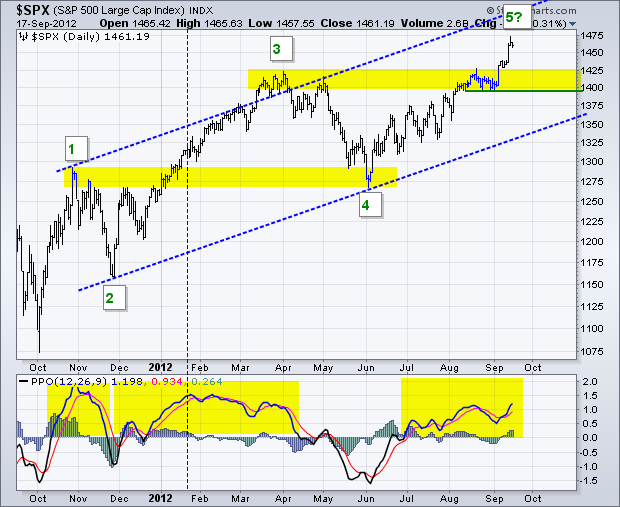

There is no change on the 60-minute chart SPY chart. SPY has been on a tear since late July with a 10% advance in eight weeks. Also note that the ETF is up 5% in September. We do not need a momentum oscillator to know that SPY is short-term overbought and ripe for a pullback. This does not guarantee a correction, but the odds favor some sort of pullback or consolidation soon. Broken resistance and last week's consolidation mark the first support zone around 143-144. Key support remains at 139.8 for now. RSI support is set at 40.
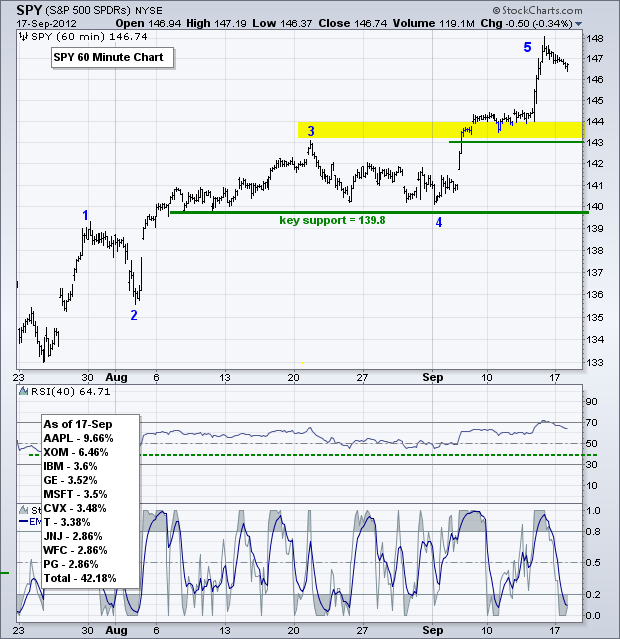
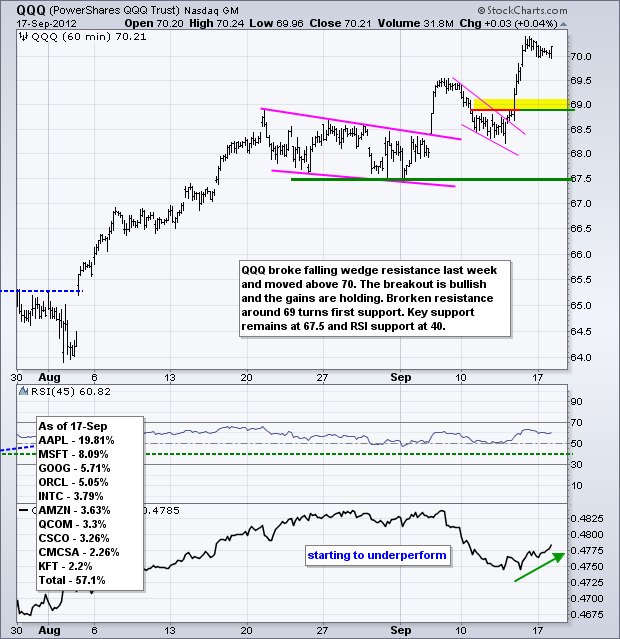

**************************************************************************
No change. The 20+ Year T-Bond ETF (TLT) fell off a cliff again in September with a 5+ percent decline in just two weeks. TLT is as oversold as stocks are overbought. Weakness in treasuries is bullish for stocks because money is being made available for riskier assets. Thursday's high marks key resistance just above 123.
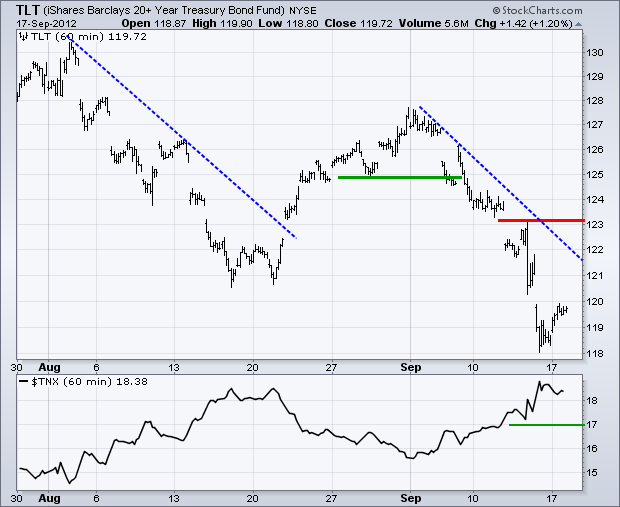
**************************************************************************
No change. The Dollar suffered its worst two-week decline since January as the US Dollar Fund (UUP) declined around 3%. This is a huge move for a currency. There are two reasons for such weakness. First, confidence in the Euro increased dramatically since European Central Bank president Mario Drahgi pledged support for the Euro and European sovereign debt. Second, the prospects and the realization of more quantitative easing are diluting the Dollar. Weakness in the Dollar is helping the stock market and commodities, but the Dollar is seriously oversold and ripe for a bounce, which could weigh on stocks and commodities in the next week or two. On the 60-minute chart, UUP went into a freefall this month and it is difficult to mark resistance, much less support. There is a small consolidation marking resistance in the 22-22.1 area and a bigger consolidation marking resistance in the 22.3-22.5 area.

**************************************************************************
The US Oil Fund (USO) got slammed in the afternoon and moved below broken resistance. Oil underperformed during the September advance and the inability to hold the breakout is negative. The trend, however, has yet to reverse because support at 35 is still holding. Watch stocks and the Dollar for clues. A pullback in stocks and bounce in the Dollar would weigh on oil and other commodities, especially overbought gold.
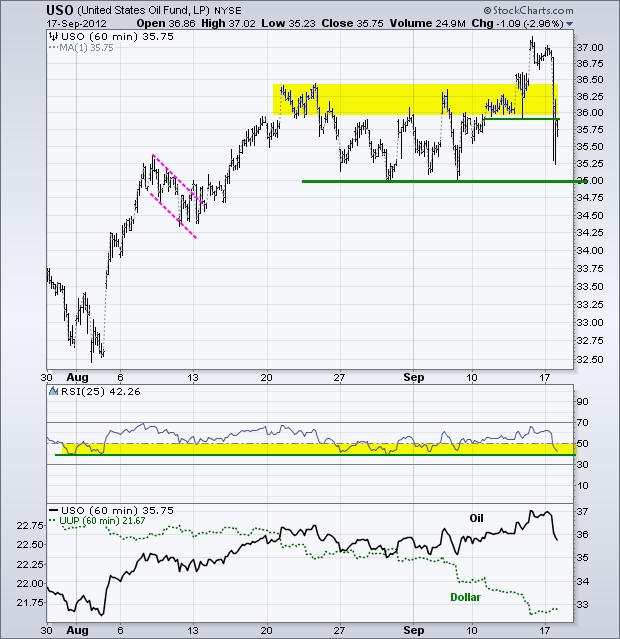
**************************************************************************
No change. The Gold SPDR (GLD) is as overbought as the Dollar is oversold. GLD is up over 7% from its late August lows near 160. The ETF broke falling wedge resistance in late September and flat flag resistance last week. The flag lows mark first support at 167. A move below this level would clearly negate the flag breakout and argue for a deeper pullback. The late August low marks key support at 159.
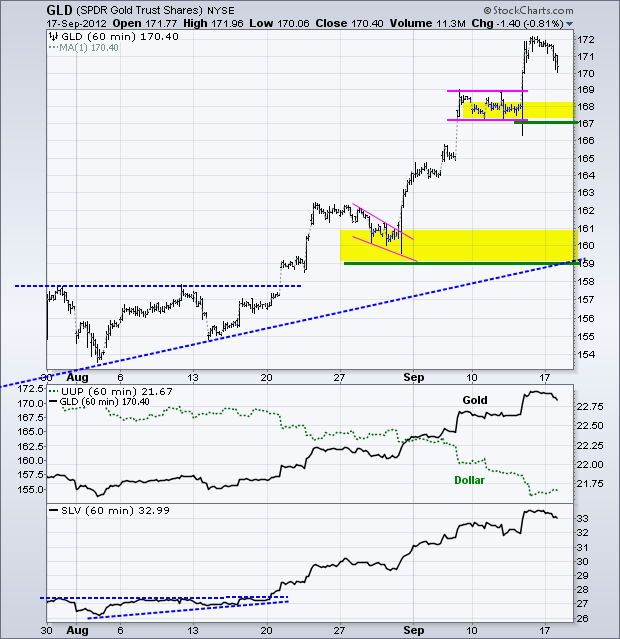
**************************************************************************
Key Reports and Events:
Tue - Sep 18 – 07:30 – FedEx Earnings
Tue - Sep 18 - 10:00 - NAHB Housing Market Index
Wed - Sep 19 - 07:00 - MBA Mortgage Index
Wed - Sep 19 - 08:30 - Housing Starts/Building Permits
Wed - Sep 19 - 10:00 - Existing Home Sales
Wed - Sep 19 - 10:30 - Oil Inventories
Wed - Sep 19 – 16:15 – ADBE Earnings
Thu - Sep 20 - 08:30 - Jobless Claims
Thu - Sep 20 - 10:00 - Philadelphia Fed
Thu - Sep 20 - 10:00 - Leading Indicators
Thu - Sep 20 - 16:15 – Oracle Earnings
Fri - Sep 21 – 08:30 – Darden Restaurants and KB Home Earnings
Sat – Oct 06 – 09:00 – EU Summit
Charts of Interest: Tuesday and Thursday
This commentary and charts-of-interest are designed to stimulate thinking. This analysis is not a recommendation to buy, sell, hold or sell short any security (stock ETF or otherwise). We all need to think for ourselves when it comes to trading our own accounts. First, it is the only way to really learn. Second, we are the only ones responsible for our decisions. Think of these charts as food for further analysis. Before making a trade, it is important to have a plan. Plan the trade and trade the plan. Among other things, this includes setting a trigger level, a target area and a stop-loss level. It is also important to plan for three possible price movements: advance, decline or sideways. Have a plan for all three scenarios BEFORE making the trade. Consider possible holding times. And finally, look at overall market conditions and sector/industry performance.

About the author:
Arthur Hill, CMT, is the Chief Technical Strategist at TrendInvestorPro.com. Focusing predominantly on US equities and ETFs, his systematic approach of identifying trend, finding signals within the trend, and setting key price levels has made him an esteemed market technician. Arthur has written articles for numerous financial publications including Barrons and Stocks & Commodities Magazine. In addition to his Chartered Market Technician (CMT) designation, he holds an MBA from the Cass Business School at City University in London.
Learn More





